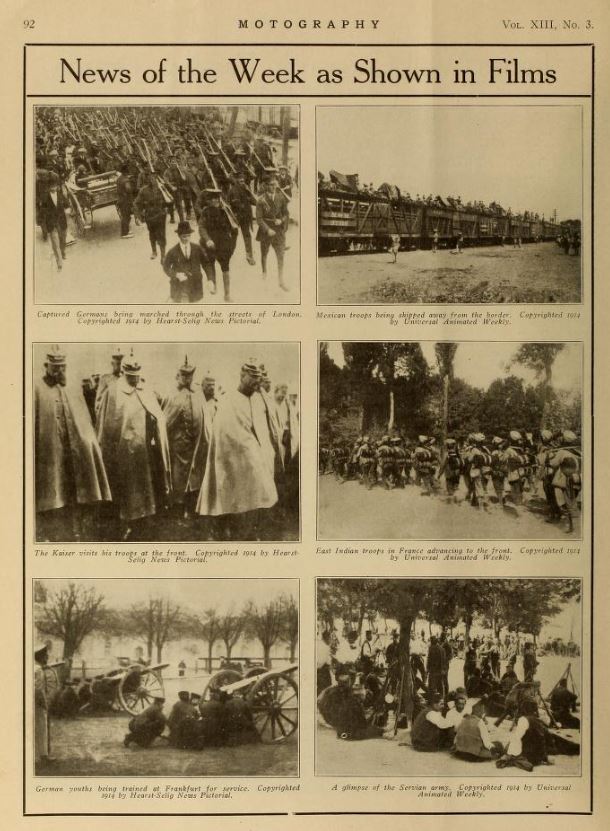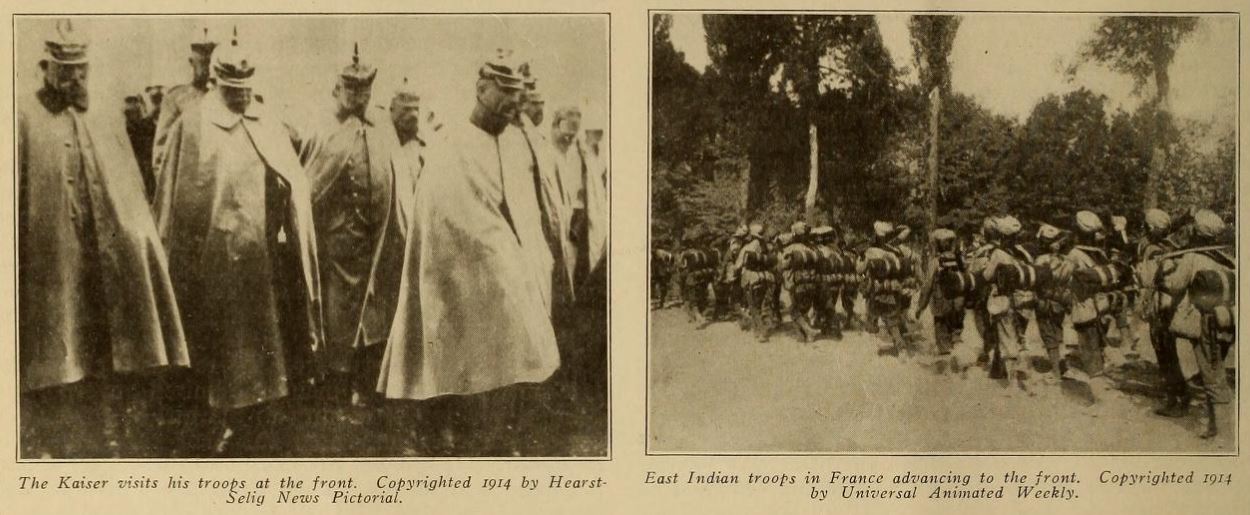Arthur Guy Empey was a member of the US Cavalry who resigned to volunteer for the British Army during World War One. He was wounded during the Battle of the Somme. When the US entered the war, he tried to rejoin the US Army, but was rejected because of his wounds and possibly because of some disparaging comments about American draftees. He wrote a book, Over the Top, about his experiences during the war. With the 100th anniversary of the war, I thought it might be interesting to post his story. Empey later became a prolific pulp magazine author, a movie star and producer, and a playwright.
From "Tommy's Dictionary of the Trenches" by Empey:
"'Estaminet.' A French public house, or saloon, where muddy water is sold for beer."
"Fag. Cigarette. Something Tommy is always touching you for."
"'Fag issue.' Army issue of cigarettes, generally on Sunday."
"Maconochie. A ration of meat, vegetables, and soapy water, contained in a tin. Mr. Maconochie, the chemist who compounded this mess, intends to commit 'hari kari' before the boys return from the front. He is wise."
"Mess Orderly. A soldier detailed daily to carry Tommy's meals to and from the cook-house."
CHAPTER I -- From Mufti to Khaki
CHAPTER II -- Blighty to Rest Billets
CHAPTER III -- I Go to Church
CHAPTER IV -- Into the Trench
CHAPTER V -- Mud, Rats and Shells
CHAPTER VI
"BACK OF THE LINE"
OUR tour in the front-line trench lasted four days, and then we were relieved by the ____ Brigade.Going down the communication trench we were in a merry mood, although we were cold and wet, and every bone in our bodies ached. It makes a lot of difference whether you are "going in" or "going out."
At the end of the communication trench, limbers were waiting on the road for us. I thought we were going to ride back to rest billets, but soon found out that the only time an infantry man rides is when he is wounded and is bound for the base or Blighty. These limbers carried our reserve ammunition and rations. Our march to rest billets was thoroughly enjoyed by me. It seemed as if I were on furlough, and was leaving behind everything that was disagreeable and horrible. Every recruit feels this way after being relieved from the trenches.
We marched eight kilos and then halted in front of a French estaminet. The Captain gave the order to turn out on each side of the road and wait his return. Pretty soon he came back and told B Company to occupy billets 117, 118, and 119. Billet 117 was an old stable which had previously been occupied by cows. About four feet in front of the entrance was a huge manure pile, and the odor from it was anything but pleasant. Using my flashlight I stumbled through the door. Just before entering I observed a white sign reading: "Sitting 50, lying 20," but, at the time, its significance did not strike me. Next morning I asked the Sergeant-Major what it meant. He nonchalantly answered:
"That's some of the work of the R. A. M. C. (Royal Army Medical Corps). It simply means that in case of an attack, this billet will accommodate fifty wounded who are able to sit up and take notice, or twenty stretcher cases."
It was not long after this that I was one of the "20 lying."
I soon hit the hay and was fast asleep, even my friends the "cooties" failed to disturb me.
The next morning at about six o'clock I was awakened by the Lance-Corporal of our section, informing me that I had been detailed as mess orderly, and to report to the cook to give him a hand. I helped him make the fire, carry water from an old well, and fry the bacon. Lids of dixies are used to cook the bacon in. After breakfast was cooked, I carried a dixie of hot tea and the lid full of bacon to our section, and told the Corporal that breakfast was ready. He looked at me in contempt, and then shouted, "Breakfast up, come and get it!" I immediately got wise to the trench parlance, and never again informed that "Breakfast was served."
It didn't take long for the Tommies to answer this call. Half dressed, they lined up with their canteens and I dished out the tea. Each Tommy carried in his hand a thick slice of bread which had been issued with the rations the night before. Then I had the pleasure of seeing them dig into the bacon with their dirty fingers. The allowance was one slice per man. The late ones received very small slices. As each Tommy got his share, he immediately disappeared into the billet. Pretty soon about fifteen of them made a rush to the cookhouse, each carrying a huge slice of bread. These slices they dipped into the bacon grease which was stewing over the fire. The last man invariably lost out. I was the last man.
After breakfast, our section carried their equipment into a field adjoining the billet and got busy removing the trench mud therefrom, because at 8.45 A.M., they had to fall in for inspection and parade, and woe betide the man who was unshaven, or had mud on his uniform. Cleanliness is next to Godliness in the British Army, and Old Pepper must have been personally acquainted with St. Peter.
Our drill consisted of close order formation which lasted until noon. During this time we had two ten-minute breaks for rest, and no sooner the word, "Fall out for ten minutes," was given, than each Tommy got out a fag and lighted it.
Fags are issued every Sunday morning, and you generally get between twenty and forty. The brand generally issued is the "Woodbine." Sometimes we are lucky, and get "Goldflakes," "Players," or "Red Hussars." Occasionally an issue of "Life Rays" comes along. Then the older Tommies immediately get busy on the recruits, and trade these for Woodbines or Goldflakes. A recruit only has to be stuck once in this manner, and then he ceases to be a recruit. There is a reason. Tommy is a great cigarette smoker. He smokes under all conditions, except when unconscious or when he is reconnoitering in No Man's Land at night. Then, for obvious reasons, he does not care to have a lighted cigarette in his mouth.
Stretcher-bearers carry fags for wounded Tommies. When a stretcher-bearer arrives alongside of a Tommy who has been hit, the following conversation usually takes place—Stretcher-bearer, "Want a fag? Where are you hit?" Tommy looks up and answers, "Yes. In the leg."
After dismissal from parade, we returned to our billets, and I had to get busy immediately with the dinner issue. Dinner consisted of stew made from fresh beef, a couple of spuds, bully beef, Maconochie rations and water,—-plenty of water. There is great competition among the men to spear with their forks the two lonely potatoes.
After dinner I tried to wash out the dixie with cold water and a rag, and learned another maxim of the trenches-—"It can't be done." I slyly watched one of the older men from another section, and was horrified to see him throw into his dixie four or five double handfuls of mud. Then he poured in some water, and with his hands scoured the dixie inside and out. I thought he was taking an awful risk. Supposing the cook should have seen him! After half an hour of unsuccessful efforts, I returned my dixie to the cook shack, being careful to put on the cover, and returned to the billet. Pretty soon the cook poked his head in the door and shouted: "Hey, Yank, come out here and clean your dixie!" I protested that I had wasted a half-hour on it already, and had used up my only remaining shirt in the attempt. With a look of disdain, he exclaimed: "Blow me, your shirt! Why in 'ell didn't you use mud?"
Without a word in reply I got busy with the mud, and soon my dixie was bright and shining.
Most of the afternoon was spent by the men writing letters home. I used my spare time to chop wood for the cook, and go with the Quartermaster to draw coal. I got back just in time to issue our third meal, which consisted of hot tea. I rinsed out my dixie and returned it to the cookhouse, and went back to the billet with an exhilarated feeling that my day's labor was done. I had fallen asleep on the straw when once again the cook appeared in the door of the billet with: "Blime me, you Yanks are lazy. Who in 'ell's a'goin' to draw the water for the mornin' tea? Do you think I'm a'goin' to? Well, I'm not," and he left. I filled the dixie with water from an old squeaking well, and once again lay down in the straw.
Next: CHAPTER VII -- Rations
























































